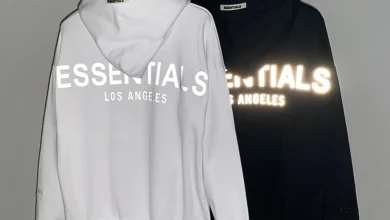Table of Contents
ToggleThe Roots of Comme des Garçons
To understand the future of comme des garcons it’s essential to delve into its origins. Founded in 1969, the brand’s name, which translates to “like boys,” is a nod to Kawakubo’s desire to blur the lines between masculine and feminine fashion. From the outset, the label was known for its minimalist, androgynous designs, a stark contrast to the more glamorous and colorful trends dominating fashion at the time. Kawakubo’s vision was not just about clothing but about creating wearable art that questioned societal norms.
Her first major breakthrough came in 1981 when Comme des Garçons debuted its collection in Paris. The show was met with a mixture of confusion and fascination. Models walked the runway in deconstructed garments, often in black, with asymmetrical cuts and unfinished hems. This approach, later termed “anti-fashion,” was a radical departure from the norm, signaling that Comme des Garçons was a force to be reckoned with in the avant-garde space.
Pioneering “Anti-Fashion”
The idea of “anti-fashion” became a hallmark of Comme des Garçons, a concept that directly opposed mainstream fashion trends. While other designers were creating collections that celebrated beauty, luxury, and femininity, Kawakubo was focused on creating clothes that evoked deeper thoughts and emotions. Her work wasn’t necessarily meant to be conventionally “beautiful,” but rather to provoke, challenge, and question.
This rejection of traditional fashion aesthetics has allowed Comme des Garçons to remain at the forefront of avant-garde fashion for decades. By constantly experimenting with shapes, fabrics, and silhouettes, the brand has stayed relevant, not by following trends but by continually redefining what fashion can be. The focus has always been on innovation, often leading Kawakubo to produce pieces that feel more like sculptural works of art than wearable garments.
Defying Gender Norms and Fashion Conventions
One of the ways in which Comme des Garçons has shaped the future of avant-garde fashion is through its consistent defiance of gender norms. Long before the concept of gender fluidity became a buzzword in the fashion industry, Kawakubo was creating collections that blurred the lines between menswear and womenswear. Her collections often feature oversized blazers, trousers, and jackets that could easily be worn by either gender, rejecting the binary distinctions that define traditional fashion.
This approach has influenced an entire generation of designers who see fashion as a tool for self-expression rather than something constrained by gender. Brands like Gucci, Balenciaga, and Vetements have adopted similar approaches in recent years, but Comme des Garçons remains a pioneer in this space, pushing the boundaries further with each collection. Kawakubo’s belief that fashion should not be confined to gender is one of the reasons her work continues to resonate in today’s increasingly progressive world.
Collaborations with Iconic Brands
Another reason https://commedesgarconsshop.com/ is seen as the future of avant-garde fashion is its innovative approach to collaborations. While high-fashion brands collaborating with streetwear labels is common today, Comme des Garçons has been doing it for decades. Some of their most iconic collaborations include partnerships with brands like Nike, Supreme, and even Disney, blending high fashion with popular culture.
These collaborations are not just about slapping a logo onto a piece of clothing; they are about creating something entirely new. Each partnership results in a fusion of ideas, merging the avant-garde aesthetics of Comme des Garçons with the more mainstream appeal of their collaborators. This willingness to merge different worlds has kept Comme des Garçons at the cutting edge of fashion, appealing to both high-fashion connoisseurs and everyday streetwear enthusiasts.
These collaborations also highlight Kawakubo’s understanding of the ever-changing fashion landscape. In a world where streetwear has become a dominant force, Comme des Garçons has embraced this shift, incorporating elements of street culture into its collections without losing its avant-garde essence. This adaptability is a key reason the brand remains relevant in a rapidly changing industry.
The Impact of Comme des Garçons on Fashion as Art
Perhaps one of the most significant contributions Comme des Garçons has made to avant-garde fashion is the elevation of fashion as a form of art. Rei Kawakubo has long insisted that her collections are not just about creating clothes but about exploring ideas, emotions, and philosophical concepts. Her 2017 exhibition at the Metropolitan Museum of Art’s Costume Institute, titled “Rei Kawakubo/Comme des Garçons: Art of the In-Between,” was a testament to her influence as both a designer and an artist.
The exhibition showcased Kawakubo’s work as a bridge between fashion and art, emphasizing the sculptural quality of her designs and her ability to challenge conventional notions of beauty. By blurring the lines between fashion and art, Comme des Garçons has inspired a new generation of designers to view their work through a more conceptual lens. Today, brands like Iris van Herpen and Maison Margiela take cues from Kawakubo’s approach, creating collections that are as much about artistic expression as they are about fashion.
The Rise of Conceptual Fashion
In recent years, the fashion world has seen a rise in conceptual fashion, a trend that Comme des Garçons has been championing for decades. Conceptual fashion is about more than just aesthetics; it’s about telling a story, making a statement, or even sparking a cultural conversation. Kawakubo’s work has always been deeply conceptual, often drawing inspiration from abstract ideas rather than following seasonal trends.
As consumers become more conscious of their clothing choices, they are gravitating towards brands that offer more than just superficial beauty. People are seeking out designs that reflect their values, challenge their perceptions, and make them think. Comme des Garçons, with its rich history of conceptual fashion, is well-positioned to lead the charge in this new era of fashion, where meaning and narrative are just as important as design.
The Future of Comme des Garçons in Avant-Garde Fashion
So, is Comme des Garçons the future of avant-garde fashion? The answer seems to lie in the brand’s ability to continuously evolve while staying true to its core principles. Rei Kawakubo’s refusal to conform to traditional fashion standards, her groundbreaking collaborations, and her commitment to fashion as an art form have made Comme des Garçons a lasting force in the industry.
As fashion becomes more inclusive, conceptual, and boundary-pushing, Comme des Garçons is already ahead of the curve. The brand’s influence can be seen in the rise of gender-neutral collections, the increasing intersection of fashion and art, and the growing popularity of anti-fashion aesthetics. In a world where fashion is constantly changing, Comme des Garçons remains a constant source of innovation and inspiration.
While the future of fashion is unpredictable, one thing is clear: Comme des Garçons will continue to play a pivotal role in shaping the landscape of avant-garde fashion. Whether through its daring designs, its thought-provoking concepts, or its collaborations that merge the worlds of high fashion and streetwear, Comme des Garçons is not just a part of the future—it is the future of avant-garde fashion.





